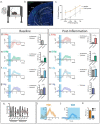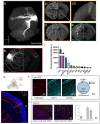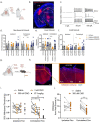This is a preprint.
The Secondary Somatosensory Cortex Gates Mechanical and Thermal Sensitivity
- PMID: 37461707
- PMCID: PMC10350168
- DOI: 10.21203/rs.3.rs-2976953/v1
The Secondary Somatosensory Cortex Gates Mechanical and Thermal Sensitivity
Update in
-
The secondary somatosensory cortex gates mechanical and heat sensitivity.Nat Commun. 2024 Feb 12;15(1):1289. doi: 10.1038/s41467-024-45729-7. Nat Commun. 2024. PMID: 38346995 Free PMC article.
Abstract
The cerebral cortex is vital for the perception and processing of sensory stimuli. In the somatosensory axis, information is received by two distinct regions, the primary (S1) and secondary (S2) somatosensory cortices. Top-down circuits stemming from S1 can modulate mechanical and cooling but not heat stimuli such that circuit inhibition causes blunted mechanical and cooling perception. Using optogenetics and chemogenetics, we find that in contrast to S1, an inhibition of S2 output increases mechanical and heat, but not cooling sensitivity. Combining 2-photon anatomical reconstruction with chemogenetic inhibition of specific S2 circuits, we discover that S2 projections to the secondary motor cortex (M2) govern mechanical and thermal sensitivity without affecting motor or cognitive function. This suggests that while S2, like S1, encodes specific sensory information, that S2 operates through quite distinct neural substrates to modulate responsiveness to particular somatosensory stimuli and that somatosensory cortical encoding occurs in a largely parallel fashion.
Conflict of interest statement
Declaration of Interests: CJW is a founder of Nocion Therapeutics, Quralis and Blackbox Bio.
Figures





References
Publication types
Grants and funding
LinkOut - more resources
Full Text Sources

